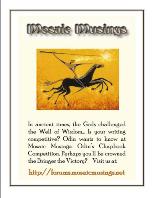  |
 Aug 3 03, 08:17 Aug 3 03, 08:17
Post
#1
|
|
|
Group: Administrator Posts: 18,892 Joined: 1-August 03 From: Massachusetts Member No.: 2 Real Name: Lori Kanter Writer of: Poetry & Prose Referred By:Imhotep |
Whenever one hears an author talk about writing or selling a series, it is almost always assumed that they are talking about a novel series. That is one of the more subtle forms of the kind of novelistic chauvinism that has plagued the mystery writing field in recent years. Such was not always the case, though. Fifty years ago, if a mystery author was working with a series character, chances were equally good they were speaking about short stories.
The classic example of a series short story character is of course Sherlock Holmes, who existed largely in the short form. Sir Arthur Conan Doyle's eccentric sleuth seemed to work better in short stories than in novels (check out The Valley of Fear, for instance, a Holmes "novel" that is really two novellas pasted together, one of which involves Holmes while the other does not). And even though the most celebrated of all of Holmes' exploits, The Hound of the Baskervilles, is a novel, it is a rather short one. Contemporaries of Doyle, such as Melville Davisson Post, creator of "Uncle Abner," and Jacques Futrelle, author of "The Thinking Machine" detective stories, never strayed far from the short form. That tradition continued through the first half of the century with such series as Hugh Wiley's "Mr. Wong" stories for Colliers Magazine and Lillian de la Torre's delightful "Dr. Sam. Johnson" stories, which appeared in Ellery Queen's Mystery Magazine, and is carried on today by the likes of Golden Derringer winner Ed Hoch, who juggles several short story series simultaneously, featuring such varied characters as supernaturalist Simon Ark, gypsy Michael Vlado and reformed thief Nick Velvet. The short story series may have become less visible in today's market, but it is still there. Today's series authors, though, face challenges that their predecessors did not, and not simply from the standpoint of working in a marketplace that is greatly reduced from what authors in the 1930s through the 60s enjoyed. Modern mystery readers, whether they favor short stories or novels, are no longer willing to accept characters whose personality traits either never change or are never explained. Instead they demand recognizably human characters with histories, backgrounds and real-life problems (and let's face it: despite the attraction of such genre superstars as Sherlock Holmes or Nero Wolfe, how many of us have ever met real people that were even remotely like them?). Novelists, of course, have enough room to fit in an interesting backstory to explain the character's outlook on life, while taking the character on a physical or emotional journey of some sort that will ultimately affect the character's life -- a character arc, in other words. But how does the short story writer contend with these demands in only a few thousand words? I learned first hand both the challenges and joys in writing a short story series in 1995, after I had sold a story titled "The Adventure of the Left Behind Wife," featuring Amelia Watson, the second (and theretofore unheralded) wife of Dr. John H. Watson, to Murderous Intent Mystery Magazine. Very shortly after selling the tale, MIMM's editor Margo Power suggested that I continue the character in other stories for the magazine. I was, of course, both flattered and delighted at the suggestion since, even in its infancy, MIMM was a terrific publication. But at the same time, I approached the idea with great trepidation. I had never attempted any kind of a series before, not even a sequel, and I wasn't at all sure I could do it. And secretly, I felt that I had said all there was to say about Amelia Watson in the first story. However, I agreed to give it a try, figuring that if my first attempt at continuing the character was a disaster, I'd bury it and nobody would ever know. Fortunately, the character that I believed I had exploited for all she was worth was only beginning to reveal herself to me, and the second story was not a disaster. It was, in fact, accepted and published, and the series was off and running. But it was not long before that little ghost-voice came back to whisper in my ear: "Okay, NOW what do you do with her?" Part of this trepidation came from the fact that I knew I could not keep rehashing the same elements that I had established in the original story, which centered around the somewhat adversarial relationship between Holmes and Amelia, each of whom view the other as a rival for the attention of Dr. Watson. To do so would have bored everyone, including me. But neither, I felt, could I throw away the character dynamics that had made the initial story work in the first place. For the sake of the series, I knew I had to find both an inner and outer character arc for Amelia: the inner arc being the "journeys" I would take her on within the confines of each story; the outer arc being the overall journey governing the entire series. With a little thought, and a lot of writing, the key to resolving this ongoing problem came in four stages. 1) PERSONALITY - As Amelia's personality quickly and fully developed, I realized there was a lot more to her than her opinion of Sherlock Holmes. She holds opinions of virtually everything, and rarely shows hesitancy in expressing them. As a result, I was able to free her from having to replay her arguments with Holmes and let her move on to other matters. Furthermore, having her let go of Holmes, I was able to let go of him as well. Of the seventeen Amelia stories written to date, Holmes appears in only nine, and among those he has sometimes been relegated to brief cameo appearances. 2) REACTION - One of things that has enabled me to keep the series going and keep it (I hope) fresh is giving the lead character new things to react to, whether it be setting, situation or a new character. Lately, I've given Amelia something rather unexpected to react to: changes in her husband. I've taken the character of Dr. Watson on a much further personal journey than either Amelia or Holmes, slowly turning the humble, loyal doctor into something of an Edwardian celebrity, a shift in his traditional "sidekick" role that has opened up more areas in which to explore Amelia's character while avoiding the dreaded "rut." 3) WHITE SPACE - White space is a term I use differently in different contexts, but in context of writing it describes the periods that occur before or after a story, when the reader isn't "looking," more specifically, the things that take place during those times. For a series, it is the area in between stories. Opening a story half-way through a situation or an occurrence that began in white space takes away the balanced (at rest) situation and allows the character to begin that story in movement. This has been particularly helpful in keeping the Amelia/Holmes relationship alive, since some stories begin with Amelia feeling very charitable toward Holmes as a result of something that has happened in white space, while others show her incensed at Holmes (or vice versa) because of whatever took place. Thus by starting a story in the middle of either motion or emotion, one has increased the capacity for creating a satisfying, non-repetitive emotional arc. 4) CHARACTER, CHARACTER, CHARACTER - Some readers may have noticed that up to this point I have not mentioned either the plot of a story or the mystery that is at its core. This is because the actual mystery is often the last thing that comes to me when I'm plotting a story. More important, in my view, is character. A story without strong character motivations is nothing more than a game of "Clue," and a plot that does not emanate directly from the characters' desires and emotions is just a timepiece made out of words: it runs, but it's not alive. The way to keep readers coming back for more of any series is to offer them characters they not only know and love, but who still hold the capacity to surprise them, no matter how many times they've visited already. ### http://www.thewindjammer.com/smfs/newsletter/index.html ·······  ······· ·······"It's a dangerous business, Frodo, going out your door. You step into the Road, and if you don't keep your feet, there is no knowing where you might be swept off to." ~ J.R.R Tolkien, The Lord of the Rings
Collaboration feeds innovation. In the spirit of workshopping, please revisit those threads you've critiqued to see if the author has incorporated your ideas, or requests further feedback from you. In addition, reciprocate with those who've responded to you in kind. "I believe it is the act of remembrance, long after our bones have turned to dust, to be the true essence of an afterlife." ~ Lorraine M. Kanter Nominate a poem for the InterBoard Poetry Competition by taking into careful consideration those poems you feel would best represent Mosaic Musings. For details, click into the IBPC nomination forum. Did that poem just captivate you? Nominate it for the Faery award today! If perfection of form allured your muse, propose the Crown Jewels award. For more information, click here!  "Worry looks around, Sorry looks back, Faith looks up." ~ Early detection can save your life. "Worry looks around, Sorry looks back, Faith looks up." ~ Early detection can save your life.MM Award Winner  |
|
|
|
1 User(s) are reading this topic (1 Guests and 0 Anonymous Users)
0 Members:
  |

|
Lo-Fi Version | Time is now: 26th April 2024 - 06:45 |

















